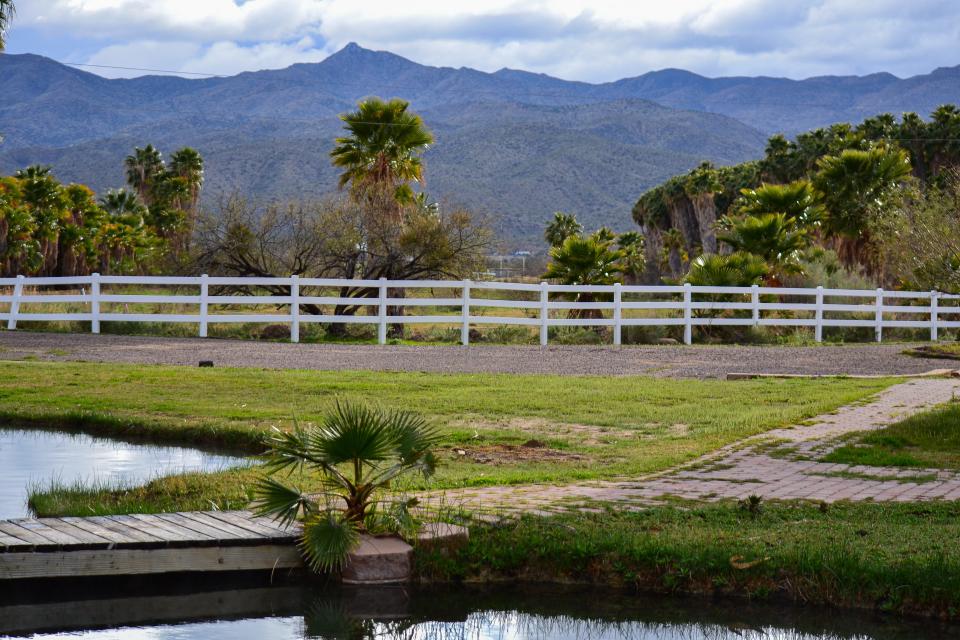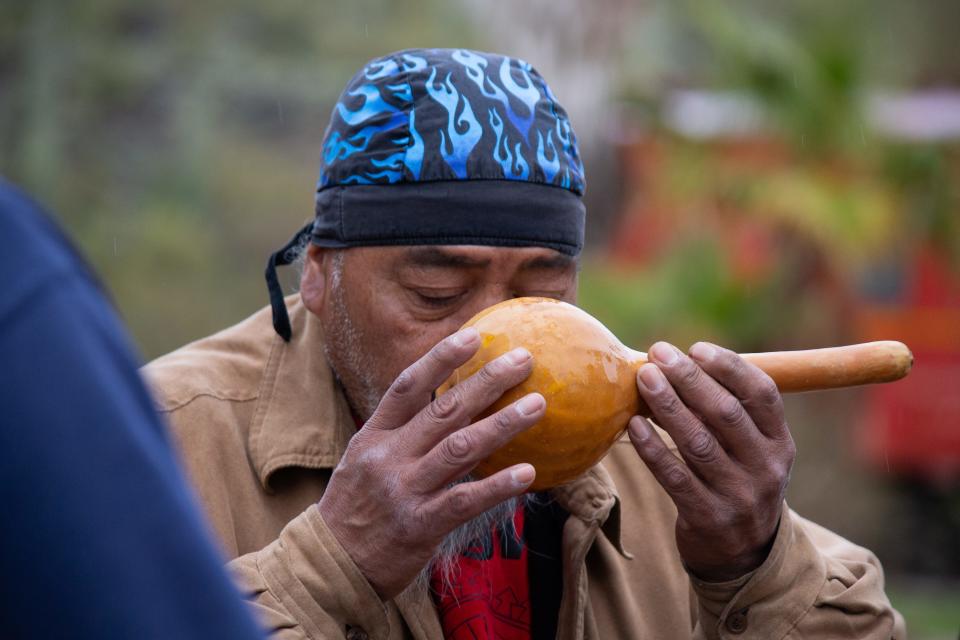Wikieup lithium mine clears one hurdle, but Hualapai neighbors still oppose the plan
The Bureau of Land Management has announced its preliminary approval for a new phase of lithium mining exploration on public lands near the rural community of Wikieup and adjacent Hualapai Tribe land.
Arizona Lithium, an Australian-based mining company, expects to find high-grade lithium carbonate, a mineral used to produce batteries for electric vehicles and portable electronic devices.
BLM's approval would permit the drilling of 131 new holes. According to documents, the project site covers approximately 613 acres, with only about 21 acres planned for land disturbance and a maximum depth of 360 feet.
Drilling activities are proposed to last around 18 months to assess the potential for viable mining. If the company decides to proceed with actual mining, it must submit a new operations plan for BLM's review.
Questions remain about where the company will get the water it needs for its operations since most residents and businesses in the area depend on groundwater wells.
To approve projects like this, BLM must conduct an environmental analysis under the National Environmental Policy Act and a tribal consultation under Section 106 of the National Historic Preservation Act to consider possible impacts.
Ka-Voka Jackson, director of the Hualapai Cultural Resources Department and Tribal Historic Preservation officer, is the tribal representative for this project.
"The Hualapai Tribe is very disappointed in the decision that BLM made," said Jackson, who holds an M.S. in ecology. "The tribe does support the transition to a green economy, but it can't occur at the expense of Indigenous nations."

The mining claims surround a sacred site known in the Hualapai language as Ha'Kamwe', later named in English as Cofer Hot Springs.
This green oasis, from which warm water emanates even in cold times, has been used by native Indigenous communities for ceremonial and medicinal purposes.
Jackson said the mine would impact tribal religious and spiritual practices in Ha'Kamwe' and the Hualapai Tribe-owned Cholla Canyon Ranch, where the hot spring is located.
Concerns over mine proximity to the sacred spring
In 2019, the Australian company Hawkstone Mining Limited, operating as Arizona Lithium Limited, filed the third phase of its exploration plan under the name Big Sandy Inc.
Phases one and two of the exploration project consisted of drilling 16 and 37 holes.
Since then, the mining company has encountered opposition from Indigenous people, primarily from the Hualapai Tribe, as well as environmental activists and other local community members and allies.

They aim to prevent any potential environmental or cultural risks associated with lithium mining in the Hualapi's historical homelands.
"Even though this is a green energy project," Jackson said, "it should not come at the expense of Indigenous sacred places."
Although mining exploration did not take place within the Hulapai property but on public lands overseen by BLM, Ivan Bender, who was the caretaker of Ha'Kamwe', said he witnessed the springs' water levels go down after the drilling process.
"I noticed a change in our water," Bender said. "We've lost seven feet of water in almost four years."
BLM officials said the groundwater well used by the mining company, within a few hundred feet of the sacred Ha'Kamwe', is not hydrologically connected to the hot spring. The office still asked Big Sandy Inc. to stop using it.
The community fears the overpumping of groundwater and contamination of water, soil, and even air, as the project entails an open-pit mine. Still, the more significant consideration is the water.
"We're primarily concerned about the puncturing of the aquifer that could occur as a result of this project," Jackson said.
Based on the public comments on the exploration plan, Big Sandy Inc. agreed not to use groundwater wells near Ha'Kamwe or drill a new well. Instead, the company proposes to purchase water from Wikieup, the largest and closest rural community, with a population of about 135 people.
In the approved document, the applicant anticipates trucking an estimated 165,000 gallons of water from Wikieup's municipal supply.
Wikieup, however, has no municipal water supply or central provider; the primary water source for residents and businesses there is groundwater-using wells.
"BLM did not adequately analyze the impacts of this project," Jackson said.
In Arizona, 40% of the state's water supply comes from groundwater, which is the source of springs and wells, sustaining rivers, streams and wildlife habitats in the state’s desert environment.
According to Doug MacEachern, communications administrator with the Arizona Department of Water Resources, Wikieup is not in an active management area.
"It's in a part of rural Arizona where we have no authority to regulate the amount of water that's extracted," MacEachern said. "It's an issue that is not regulated."
Mining and tribes: Clean energy or healthy river? Why lines in the debate aren't as clear at this Western mine
MacEachern says the Groundwater Management Act of 1980 does not allow ADWR to interfere in that area.
After The Republic's inquiry, the mining company in charge of the exploration drilling process responded via email:
"Given the water limitations in Wikieup, we are reevaluating the source of water for exploratory drilling. It will either come from a commercial source in Wikieup or outside areas such as Kingman."
Kingman is at least 50 miles away.
"In addition, we are investigating different kinds of drilling that use even less water than what is in the now approved plan. Any updates to our plan of exploration will be submitted to BLM for approval."
According to Dolores Garcia, the BLM public affairs specialist, the company doesn't need BLM's approval for where it gets the water as long as it doesn't extract the water on site.
The plan's approval took about five years
Big Sandy Inc. filed the third phase of the current exploration plan in 2019. Still, BLM did not start its NEPA review until 2021 to determine whether the proposed actions could have significant environmental effects.
Jerry Davis, deputy state director of renewable resources and planning from BLM, said the tribal consultation was the part of the process that required the most back-and-forth.
"The tribes had legitimate, serious concerns, and we wanted to ensure that we had ample time to work with them," Davis said.
BLM states in its NEPA database that it consulted the Colorado River Indian Tribes, Chemehuevi Indian Tribe, Fort Mojave Indian Tribe, Hopi Tribe, Hualapai Tribe, and Navajo Nation.
To facilitate the processes, Arizona Lithium announced that the drill program will be managed by the tribal-owned Navajo Transitional Energy Company as part of their mining services agreement.
NTEC will be responsible for managing the permitting requirements, additional exploration drilling, mine design, environmental assessments and development until mining commences.
Protests: Proposed lithium mine near Wikieup would endanger sacred sites, Native activists say
In compensation, NTEC will receive Arizona Lithium shares valued at 7.5 cents per share, subject to the full permitting of the Big Sandy Lithium Project.
Arizona Lithium expects to commence a bulk sample in July.
Yet, Davis said, "The exploration plan won't actually get officially approved until the end of the 30-day appeal period that we're currently in."
After that period, if the exploration plan is fully approved, Arizona Lithium would be required to submit a reclamation bond that BLM would need to accept.
"That would provide for surety of restorations of any resource damages if the proponent didn't take care of that themselves," Davis said. "We're anticipating that the bond for this project would be approximately $60,000." The amount is still subject to adjustment.
Jackson said that the Hualapai Tribe is still analyzing the decision and what options they have.
Prayer run and rally to protect Ha'Kamwe'
In March, Ivan Bender was the caretaker of Ha'Kamwe'. Concerned about the spring's future, he led a 200-mile prayer run from Peach Springs to the Arizona State Capitol.
He invited his community, sharing the information on the local newsletter, radio and social media.
Children, adults and elders from diverse communities and tribes joined the demonstration in opposition to the Big Sandy Lithium Project and expressed concern for preserving sacred waters.
During the days Bender left the spring for the prayer run, he said he left without pay. He doesn't do the advocating job for money but for conviction, to protect the place of his ancestors and the values he believes in, and to protect the water and Ha'Kamwe'.
Bender said his tribe hired another person, who is not part of the tribe, to work in the Cholla Canyon Ranch. He was supposed to care for the place during his absence.
But when Bender returned, he found that the big old mesquite tree that used to be planted next to the well had been cut down.
"That guy cut down that tree," Bender said, "when I saw that, I was furious. I've shed tears for this sacred land. So I pushed him."
After that incident over the tree, Bender was removed from his position as caretaker of Ha'Kamwe'. He is now scheduled for a jury trial next month.
"I was protecting the land," Bender said. "I stood up and fought for something I believe in, but now, I have to deal with this."
Trilce Estrada Olvera writes about environmental issues for The Arizona Republic and azcentral. Send comments and story tips to trilce.estradaolvera@arizonarepublic.com.
Environmental coverage on azcentral.com and in The Arizona Republic is supported by a grant from the Nina Mason Pulliam Charitable Trust.
Sign up for AZ Climate, our weekly environment newsletter, and follow The Republic environmental reporting team at environment.azcentral.com and @azcenvironment on Facebook, X and Instagram.
You can support environmental journalism in Arizona by subscribing to azcentral.com today.
This article originally appeared on Arizona Republic: BLM approves lithium exploration near Wikieup and Hualapai Tribe land

